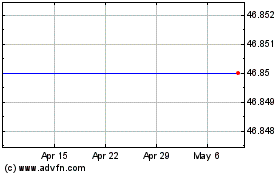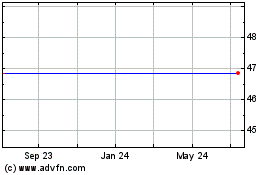Nikkei Leads Gains in Asian Shares
October 11 2016 - 12:40AM
Dow Jones News
Rising crude-oil prices and weaker local currencies helped boost
Asian share markets on Tuesday, with Japan's Nikkei standing out as
the region's best performer.
The Nikkei Stock Average was up 1.2%, led by exporters amid a
weaker yen, with Australia's S&P/ASX 200 rising 0.2% and Hong
Kong's Hang Seng Index reversing early gains to fall 0.3%. Both the
Japanese and Hong Kong markets were closed on Monday.
Meanwhile, the Shanghai Composite Index gained 0.3%, building on
Monday's 1.5% rise, as Chinese investors returned from a weeklong
national holiday.
Risk-on sentiment is returning to Asia, thanks to higher oil
prices due to production cuts, as well as recent gains in U.S.
markets, said Alex Furber, a senior client services executive at
CMC Markets.
"There is going to be general relief as well at the prospect of
a [Donald] Trump win receding," Mr. Furber said, following the
second televised U.S. presidential debate. Markets are less
favorable to Mr. Trump as they dislike the uncertainty of his
economic policies, analysts say.
"A fair bit of U.S. trading partners are in Asia" and may feel
relieved for now, said Mr. Furber.
On Monday, crude oil prices hit a one-year high in the U.S.,
after Russian President Vladimir Putin said the country would
support the Organization of the Petroleum Exporting Countries'
attempt to cut its collective output.
Though crude prices were slightly weaker in Asian trade Tuesday
on profit-taking.
China's biggest oil companies listed in Hong Kong got a lift
from higher oil prices, with offshore oil producer Cnooc gaining
1.4% and PetroChina adding 1.6%.
Meanwhile, a stronger dollar weighed on Asian currencies,
boosting the competitiveness of exports from countries in the
region.
The U.S. dollar was 0.3% higher against the Japanese yen and
0.6% stronger against the Korean won in early Asian trade.
Meanwhile, the Philippine peso was down about 0.6% against the
dollar.
The WSJ Dollar Index, a measure of the U.S. dollar against a
basket of 16 currencies, was up 0.2% in Asian trade amid rising
expectations that the U.S. Federal Reserve will raise interest
rates in December.
Meanwhile, Korea's Kospi was among the region's biggest
underperformers Tuesday, dragged lower by Samsung Electronics,
which fell 4.9% in morning trade following the company's
unprecedented move to halt sales of its flagship smartphone.
The Korean electronics giant halted production and distribution
of the Galaxy Note 7, as investigators began probing recent reports
of overheating batteries.
The Kospi was down 0.8%, while Taiwan's Taiex fell 0.6%. Many of
Taiwan's top firms supply components to Samsung.
Among other Asian currencies, China fixed the yuan's exchange
rate 0.1% weaker against the U.S. dollar Tuesday, the second
consecutive weaker yuan fixing this week.
The Chinese yuan was guided toward a six-year low against the
U.S. dollar on Monday following a weeklong holiday, and after the
currency was included in the International Monetary Fund's elite
basket of reserve currencies.
Analysts expect further declines in the yuan in the near term
amid capital outflow worries.
"The [People's Bank of China] will need to step in to manage
market expectations and prevent subsequent global chaos of currency
devaluations," Gao Qi, a foreign-exchange strategist at Scotiabank
in Singapore, said in a note.
Saumya Vaishampayan, Lucy Craymer, Alison Sider, Jonathan Cheng
and Eun-Young Jeong contributed to this article.
Write to Kenan Machado at kenan.machado@wsj.com
(END) Dow Jones Newswires
October 11, 2016 00:25 ET (04:25 GMT)
Copyright (c) 2016 Dow Jones & Company, Inc.
Petrochina (NYSE:PTR)
Historical Stock Chart
From Mar 2024 to Apr 2024

Petrochina (NYSE:PTR)
Historical Stock Chart
From Apr 2023 to Apr 2024
